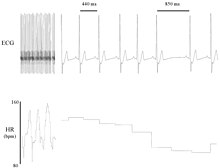

Heart rate variability (HRV) is the physiological phenomenon of variation in the time interval between heartbeats. It is measured by the variation in the beat-to-beat interval.
Other terms used include "cycle length variability", "R–R variability" (where R is a point corresponding to the peak of the QRS complex of the ECG wave; and R–R is the interval between successive Rs), and "heart period variability".[1] Measurement of the RR interval is used to derive heart rate variability.[1]
Methods used to detect beats include ECG, blood pressure, ballistocardiograms,[2][3] and the pulse wave signal derived from a photoplethysmograph (PPG). ECG is considered the gold standard for HRV measurement[4] because it provides a direct reflection of cardiac electric activity.[5]
- ^ a b Johnston BW, Barrett-Jolley R, Welters ID (2020). "Heart rate variability: Measurement and emerging use in critical care medicine". Journal of the Intensive Care Society. 21 (2): 48–157. doi:10.1177/1751143719853744. PMC 7238479. PMID 32489411.
- ^ Brüser C, Stadlthanner K, de Waele S, Leonhardt S (September 2011). "Adaptive beat-to-beat heart rate estimation in ballistocardiograms". IEEE Transactions on Information Technology in Biomedicine. 15 (5): 778–786. doi:10.1109/TITB.2011.2128337. PMID 21421447. S2CID 10126030.
- ^ Brüser C, Winter S, Leonhardt S (2012). "Unsupervised Heart Rate Variability Estimation from Ballistocardiograms". 7th International Workshop on Biosignal Interpretation (BSI 2012), Como, Italy.
- ^ Schäfer A, Vagedes J (June 2013). "How accurate is pulse rate variability as an estimate of heart rate variability? A review on studies comparing photoplethysmographic technology with an electrocardiogram". International Journal of Cardiology. 166 (1): 15–29. doi:10.1016/j.ijcard.2012.03.119. PMID 22809539.
- ^ Lam E, Aratia S, Wang J, Tung J (2020-11-03). "Measuring Heart Rate Variability in Free-Living Conditions Using Consumer-Grade Photoplethysmography: Validation Study". JMIR Biomedical Engineering. 5 (1): e17355. doi:10.2196/17355. ISSN 2561-3278. S2CID 226305881.